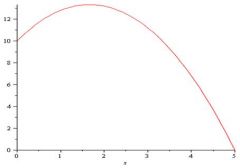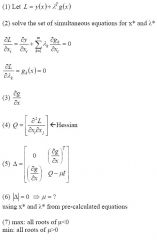![]()
![]()
![]()
Use LEFT and RIGHT arrow keys to navigate between flashcards;
Use UP and DOWN arrow keys to flip the card;
H to show hint;
A reads text to speech;
21 Cards in this Set
- Front
- Back
|
Optimization Techniques
|
A collection of techniques for determination of the best (optimal) course of action of a decision problem under the restriction of limited resources and other constraints
|
|
|
Constrained vs unconstrained optimization
|
unconstrained optimization has no constraint on the region of search
|
|
|
Unimodal vs bimodal functions
|
Unimodal functions: have a single extreme value
Bimodal functions: have two extreme values |
|
|
Where to look for extreme values
|
boundaryies of ourfunction
discontinuities in our function |
|
|
Concave
|

ANY line connecting two points on the objective function surface lies entirely below the surface
|
|
|
Convex
|

ANY line connecting two points on the objective function surface lies entirely above the surface
|
|
|
convex set
|
any two points on the boundary of the search region can be connected by a straight line that lies ENTIRELY IN the region
|
|
|
Unrestricted functions of a single variable
(problem) |
find minimum/maximum of y=f(x)
|
|
|
Unrestricted functions:
Condition for extreme value |
if
f ' (x)=0 then x=a may be an extreme value |
|
|
Unrestricted functions:
How to determine if a possible extreme value is a maximum or minimum |
minimum:
f " (a) > 0 maximum: f " (a) < 0 if f '' (a) = 0 and f ''' (a) = 0 then examine f '''' (a) |
|
|
Unrestricted functions in multiple variables:
steps for solving |
1) ∆'y=0 --> ∂y/∂xi=0 for all i
(this gives us our possible extreme of x*=(x1*,x2*,...)) 2) A= Hessian 3) A1=a11 A2= det(B2) where B2= [a11 a12 a21 a22] A3=det[B3] where B3= [a11 a12 a13 a21 a22 a23 a31 a32 a33] etc. 3) minimum: A1>0, A2>0, A3>0, ... maximum: A1<0, A2>0, A3<0, ... |
|
|
Hessian
|
A=
[a11 a21 a31 a12 a22 a32 a12 a23 a33] where aij=d^2(y)/(dxi*dxj) i=row j=column |
|
|
Newton Raphson Method
|
1) select x0
2) evaluate F^k and Jacobian, J^k, and solve J^k*z=-F^k for z (z is defined as z=x^(k+1)-x^k) 3) if |z|<ε stop repeating we use x^(k+1) x^(k+1)=z+x^k 4) otherwise go to step 2) |
|
|
Jacobian Matrix
|
J^k=
[df1/dx1 df1/dx2 ... df1/dxn df2/dx1 df2/dx2 ... df2/dxn . . . dfm/dx1 dfm/dx2 ... dfm/dxn] |
|
|
Kuhn Tucker
|
conditions that are necessary for a solution in NON-linear programming to be optimal
|
|
|
Lagrange Multiplier
|
a method for finding the maximum/minimum of a function subject to constraints
|
|
|
Newton Raphson
|
method for finding successively better approximations to the zeros (or roots) of a real-valued function
|
|
|
Lagrange Multiplier
(step by step method) |

|
|
|
Sufficient Conditions for Kuhn Tucker Method
|
*Maximum (ie not a minimum):
Concave y Constraints form a convex set *Minimum (ie not a maximum): Covex y Constraints form a convex set |
|
|
Method of Slack Variables
(use) |
Used to change an inequality constraint into an equality constraint
|
|
|
Method of Slack Variables
(step by step) |
(1) put constraint in gi<=0 form
(2) add a new x_(k+1)^2 variable and set =0 instead of <=0 gi+x_(k+1)^2=0 (3) these are your new constraints proceed with previous methods |

